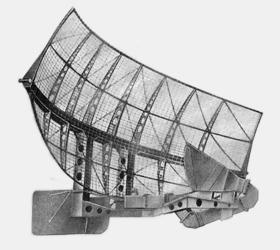AN/SPS-6
Description of the radar set, tactical-technical characteristics

Figure 1: The antenna AS430 of the radar AN/SPS-6B (1952)
| Specifications | |
|---|---|
| frequency: | 1 250 … 1 350 MHz
( L-Band) |
| pulse repetition time (PRT): | |
| pulse repetition frequency (PRF): | 150 or 600 Hz |
| pulsewidth (τ): | 4 or 1 µs |
| receive time: | |
| dead time: | |
| peak power: | 500 … 750 kW |
| average power: | |
| instrumented range: | |
| range resolution: | |
| accuracy: | |
| beamwidth: | 3.5° |
| hits per scan: | |
| antenna rotation: | 2.5; 5 to 15 rpm |
| MTBCF: | |
| MTTR: | |
AN/SPS-6
The radar set AN/SPS-6 is designed for shipboard use to supply bearing and range data to a PPI and A-Scope indicator. This equipment is used primarily on board combat vessels for aircraft detection. It has a limited value for surface craft detection while being used as an aircraft search radar. The AN/SPS-6, AN/SPS-6A, and AN/SPS-6B Radar Sets are essentially the same. The AN/SPS-6 is fitted with the antenna AS102; the AN/SPS-6A is fitted with the antenna AS429; the AN/SPS-6B and later variants are fitted with the antenna AS430. The only difference is in the vertical beamwidth of the antennas employed. The AN/SPS-6C has additionally a different antenna control unit.
The antenna AS430 as shown in Figure 1 was a unidirectional, parabolic type reflector, equipped with a wind balancing vane and had a characteristic 30 degree cosecant-squared pattern in the vertical plane. A dual feed horn on the antenna transmitted and received both radar and IFF signals. The antenna and the receiver are checked using an echo box in the antenna.
The initial sets were procured since 1947, following quickly the 6A and 6B variants. The 6C and 6D versions were introduced in 1951, and the final 6E model in 1964.
Source:
- Instruction Book for AN/SPS6-C, NAVSHIPS 91620(A), Bureau of Ships, July 21, 1952
